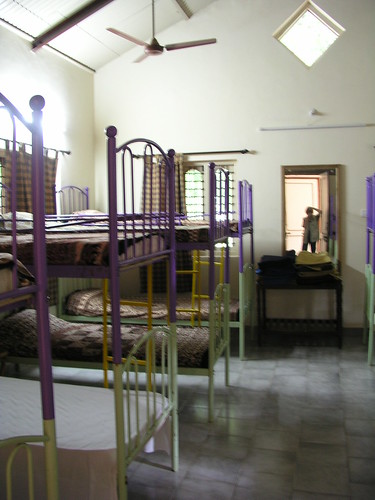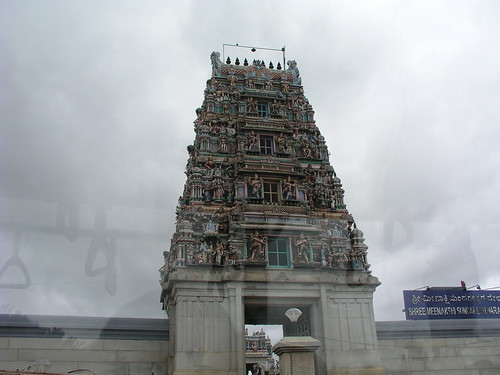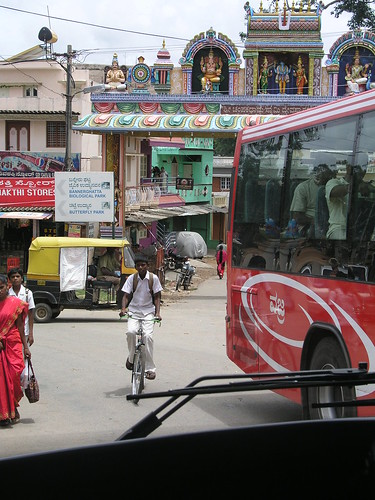I really wanted to get out of the city. Someone introduced me to another ThoughtWorker who had a reputation for being a big nature fanatic, Chirdeep Shetty. Chirdeep it turns out, is more of a jungle and large animal guy than a birder guy but he knows tons of stuff and is deeply involved in preservation issues. It was great to get to meet him.
He didn’t think much of Bannerghatta except for maybe a short afternoon visit. He suggested we plan a trip out to one of the bigger national parks like Bandipur for a long weekend. But in a weird twist of fate, in June 2009, Bangalore became began to experience an unusually dry early monsoon season, while the rest of Karnataka state became deluged with rain and severe flooding. The road into and through Bandipur was impassable. So a few days after he floated this idea, we could see it was just not going to hold water and we abandoned ship. Maybe another year…
So, there I was, high and dry without a weekend plan except to go to Bannerghatta. Known for its white tigers, this is mainly a zoo and animal rehab place. The famous tigers are in safe enclosures and they all act like it. The same goes for bears and elephants, and so on. As a visitor, where you can go on your own is highly constrained thanks to at least one incident over fifteen years ago when a few people, excited by the opportunity to get close to nature, got too close, suffering the predictable death. And that is the difference between a wildlife preserve and a theme park.
As a consequence, entry into the true parklands is more carefully limited and thus, the idea that there even are wild lands so close to the city (about 25 km) is very vague. Most people will just tell you that Bannerghatta is a zoo, good for an afternoon.
But you can do more than that. There’s a great company called Jungle Lodges which runs secure enclaves within various Indian national parks. You can stay in a cosy hut-like cottage or Spartan but cheery dormitory for a bargain rate (by American standards) that includes meals (plus beer for purchase), relevant evening entertainment (a nature video or lecture, campfire discussions) and guided walking and driving tours. Mind you, this isn't luxury touring, it's comfy touring for people who do a lot of camping in tents.

(This is me in the mirror, taking a shaky shot of the dormitory I stayed in.)
I made an on-line reservation (another caution, the process expects a minimum of two people for the cottages, so if you are a single tourist, make up a fake second guest and pay double. It's worth it.) Then, armed with the bus schedule, I got to the Kampegowda Bus Station early on a Saturday morning and found the berth for the 365 series buses to Bannerghatta. These are quite nice, modern red Volvo buses. The one-way fare was, I think 25 Rs. A real deal.
Kampegowda has so much traffic, every bus I’ve been on seems to spend about twenty minutes just navigating out of the station. It feels like an exit from a circular maze. The bus is always turning left and left again, for about five or six major intersections before it wobbles off down some zig-zag cow path lane, usually past some very nice homes, and then surprisingly, it finds the road to your destination. At that point everything becomes straight as an arrow (and I’m sure there is some remote connection to a former British military route.)
The cool thing about this bus trip is that I saw so many new scenes.
After we got past the main congestion and started heading out of Bangalore we passed an area that maybe I could say was the Indian equivalent of a Brazilian favela or an 1930’s US Depression-era tent city. For a few second, it felt like I had glimpsed a traditional village displaced in time from pre-colonial days. It was obviously a place where very poor people lived but it's not exactly what you picture as a "slum" if you are from a U. S. city. This area seemed quite unique in its response to circumstance, and, to me, expressed some cooperative spirit of the residents to dig in and make it work. But I’m just guessing based on a few drive-by views and reports in the newspaper.
From the bus, all I saw were small white structures, so closely plotted the roofs nearly touched, almost like an idea of American Navajo pueblos. They appeared to be laid out in neat formations with hard-packed dirt walkways in-between. Colorful bits of laundry gave witness to a bustling, hard-scrabble life yet the smoke from the cook fires made the buildings appear to float inside a cloud - a dream vision gifted to me by the speed of bus's passing. I wish I could have had more time to get a feel for this area, but not as a tourist gawking around. I would like to understand it as a friend of a friend or a journalist telling the story of the residents ... something beyond my current role of software consultant.
(Being in a bus, I couldn't get a good photo and have not succeeded in finding anything on the Internet that comes close to the image that my mind holds, so here's a temple that we passed.)

Then, quickly! A change of thought and scenery. The bus was driving past wetlands! Managed obviously, but wetlands nonetheless. That is, large, blocked off plots of land where natural water flows filled in natural lowlands letting reeds grow and making a home for wetland birds and animals. I love wetlands because I grew up just a short distance, about a half-mile, from one.
It wasn’t likely I would be able to get back there for birdwatching and in passing I could not see any obvious observation points as might happen in the US (in the US, funding support for wetland rehabilitation usually comes from birders and hunters so there are often observation/shooting blinds and hiking trails included in the plans). Here, wetlands in or near Bangalore exist mainly for flood control and to maintain the city water supply; people may love them for the visual relief and sense of freedom they provide but I'm not sure these lands get much official protection as nature preserves.
A blog post from March 2009 gives a good overview of the situation
But a more recent post from October, shows some progress is being made.
After the wetlands were some boring, alarming areas where you could see that land had been sold for housing developments and what was currently free and open greenery was going to be trashed and turned into urban sprawl in the next year, or maybe just trashed and then the development funding would run out. I hate to see this and I have seen this way too many times back home in Illinois, Michigan and Wisconsin. Someday, I think we’ll look back and say that we were really stupid or we won’t be here and someone else one hundred years from now will say that about us.
This boringness did not last too long. We started to get into areas that were tantalizingly still small town-y and almost woodsy feeling with some road signs suggesting that we were already in Bannerghatta, but it is easy for me to be confused by the signage so I’m not sure if any of this counted as part of the park.

Finally it appeared we were headed straight into one picture-perfect small town built into the side of a hill and totally dominated by a large gateway decorated with fantastic Hindu iconography. At the last minute, the bus turned left and in about 15 minutes we were at the park.
To be continued...
No comments:
Post a Comment